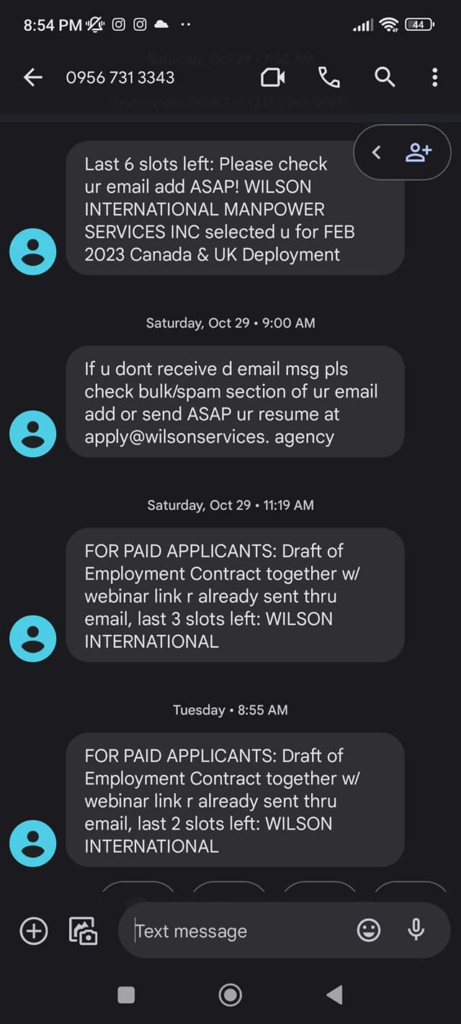The Canadian Work Permit/Visa Scam has been going on for a while now but a lot of people still fall for them. In fact, the Canadian government has a page on its website dedicated to these types of fraud. The Work Permit Scam will continue as long as there are people interested in jobs in Canada. If you or someone you know is applying for a work permit, you should make yourself aware of this scam.
What is a Canada Work Visa Scam?
A work visa scam is a type of internet scam that targets Canadian work permit applicants. Canada is a great destination for economic immigrants. However, Canada’s immigration process can be strict and, for some people, it may be difficult to become a permanent resident or to get a work permit. This makes them vulnerable to bad actors who are familiar with their pain points.
Who are the Scammers’ Targets?
Scammers who send out fake work permits often target people outside of Canada who may be seeking ways to get into the country. They may also target victims who already have a student permit and who may be looking to upgrade to a work permit.
These bad actors know that visa applicants are in a vulnerable position. Many Canadian work visa aspirants have spent thousands of dollars trying to get a work permit. Finding an employer who will accept a foreign worker is one of the key steps to getting that permit. Receiving an offer in their email will often excite the applicant and create a sense of urgency. The scammers will attempt to exploit this situation to make the applicant send personal financial information or request payment.
How Does It Work?
- Personal Data Gathering
A victim enters the scammers’ list in multiple ways. Some scammers scrape websites like social networking groups or forums. They may also create job listings on websites like indeed.com or LinkedIn. Data breach lists can also be used as a starting point. The criminal organization may also set up temporary websites and use social networks to drive traffic. Some scammers also set up PPC ads to get attention to their offer.
The goal of this step is to get a list of personal contact information of people who are interested to get Canadian Work Permits.
- Scammers send their victims a message (Job Offer)
The scam starts when the culprits contact their potential victims via email, SMS, or direct messages (DMs) on social networks. These messages will contain job offers for positions in Canada. To hook the potential victim, the message may contain a tempting salary and benefits. At the end of the message, the scammer may give the user instructions on what to do next. At this stage, the scammers could ask the victim to contact them, often using a job interview as a pretext.

Scammers send spam messages in the hopes that a few will contact them back. Most people avoid these scams by ignoring these spam messages. The scammers only need a few to take the bait to get paid.
In the message, note that they may pose as a real company with
- Fake Job Interview
During the fake online job interview, the scammer will act like a real employer or recruitment firm. They will ask about your background and the things you’ve put in your resume. The scammer’s goal here is to gain the victim’s trust.
They may also fish for personal information to get the victim emotional and hopeful to move to Canada. Some of the ways they do this is by talking about their family or their children.
Lastly, they may attempt to create some sense of urgency to make the victim take action immediately. They could do this by telling the victim that they will only hire one person for the job or that they will only hire those who complete the application process within three days.
At the end of the interview, they usually let the applicant know that they will receive an email or an SMS.

- Scammers send payment instructions
In the email or SMS, the scammers will ask the work permit applicant to submit some requirements and complete some tasks online. This is where the scam comes in. One of the requirements they may ask for is for the applicant to send money to them. This could be disguised as some sort of legitimate payment like payment for a medical exam or a background check.

- They sell victim information to other scammers
Scammers are successful when the applicant sends them the money. However, the cycle of the scam does not end there. Whether the victim falls for this scam or not, the scammers may sell their personal information to other bad actors on the dark web. This could then lead to more scam attempts.
How Do You Avoid It?
The best way to avoid scams is to be careful with your personal contact information. By keeping your contact information private, you will avoid getting your email or phone number in the lists of these criminals. Here are some of the things you can do to keep your information private:
- Avoid giving out your personal contact information on websites
- Use email providers with spam filters
- Avoid clicking links from emails and SMS from senders you are not familiar with
- Use throwaway emails when using online forms and signing up for websites
If you receive a job offer with an invitation to come to Canada, make sure to do your due diligence in researching the source before you take action. Here are some of the things you can do:
- Scrutinize the message
- Research the company name of the source of the message
- Ask for help from friends and family before you take action
- Ask online communities before sending money anywhere
- Contact the company stated in the message
What to do if you’ve been scammed
If you are one of the unlucky victims of this type of scam, you have no time to lose. Take the following steps to minimize the financial damage of this scam:
- Freeze all your financial accounts that can be accessed online
- Identify the fraudulent transactions and contact your bank to reverse them
- Contact the law enforcement agencies tasked with investigating and prosecuting these criminals
Other Scams in Canada



